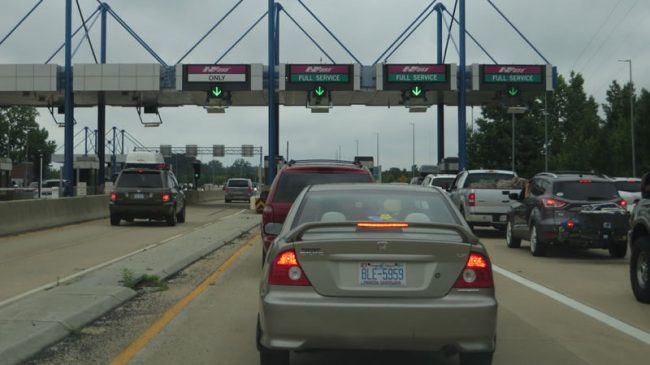Last week, I detailed how all northern Virginia state-controlled expressways will have variably priced toll lanes for automobiles and transit vehicles. While an impressive task, the key word is state-controlled. Northern Virginia has one other completely grade separated expressway that could function as a managed lane corridor today. That facility is SR 267 better known as the Dulles TollRoad and Dulles Airport Access highway.
The corridor consists of a free 4 lane roadway, built in 1962, that provides direct non-tolled access to Dulles Airport and an 8 lane tolled roadway (including 2 HOV lanes), built in 1984, that provides access to Western Fairfax and Loudoun counties. When it opened, the Dulles Toll Road was an economic catalyst that provided a needed artery between the Airport and I-495. The road opened with a toll of $0.85 in 1984 for 12 miles of travel. The price increased to $1.25 in 2005 due to inflation.
Toll prices remained reasonable until the Metropolitan Washington Airports Authority (MWAA) needed to find funding for the Silver Line extension. When the Washington Metrorail system was being conceived, an extension to Loudoun was included. Unfortunately, there was no credible way to pay for phase 2 of the Silver Line. So, ignoring the principle of users-pay/users-benefit MWAA got creative and increased the tolls on the Dulles Toll Road to build the rail line. Tolls increased from $1.25 in 2009 to $1.75 in 2010, $2.00 in 2011, $2.25 in 2012, $2.75 in 2013 and $3.50 in 2014. This was an increase in 280% over 5 years. While most toll road agencies keep their tolls artificially low for political reasons, this increase was unnecessarily high.
Compounding problems, the MWAA did not increase the tolls in a method to keep traffic moving. The agency kept a flat toll rate: the price of travel remains the same, day or night, regardless of the hour. As a result, the toll road is severely congestion during the morning and afternoon rush hours and the HOV lane fails to operate at 45 miles per hour or more 90% of the time. Federal law requires states to keep HOV lanes operating at 45 miles per hour or pay back construction costs to build the HOV lanes.
And while the free airport lanes are supposed to be for those with airport business only, many drivers use the lanes to avoid paying the $3.50 toll. Catching violators is challenging and anybody with airport business can use the lanes. One common ploy is filling up at the on-airport gas station. In fact, that station sells more gasoline than any other station in Virginia, despite being 5 cents more expensive than other stations in the area.
The Dulles Toll Road in 2016 is an expensive, poorly operated, incredibly unpopular facility that is failing federal performance standards.
Fortunately, each of the problems with the roadway can be fixed through better management. In general, the heavily underused airport access road should be opened to non-airport traffic. Sincethe HOV lane is failing, HOV vehicles should be able to use the underused airport access road for free. Additionally, single commuters should be able to use the airport access road for a variable toll. The toll would be higher on the airport access road than the current toll lanes but would vary based on congestion offering a reliable trip, similar to the way the I-495 express lanes operate today. The old HOV lane should be converted to a general purpose lane to meet the corridor’s growing population.
In order to provide significant capacity for airport users, the airport access section should be widened to three lanes in each direction. MWAA has plans to widen the roadway; however, decreasing passenger levels at Dulles has put those plans on hold. Yet MWAA has toll road customers who would pay for this capacity if only it were available.
Third, MWAA should consider eliminating free passage for airport customers. If free passage is kept it should be restricted to folks flying into and out of the airport and those picking up or dropping off passengers. Some type of ticket or parking receipt should be required to enter the road free of charge.
Fourth, and most importantly, the tolls on the currently tolled section should be reduced. With the new variable tolls for single-occupant vehicles providing much of the needed revenue in the corridor, the tolls on the toll section can decrease significantly, likely by more than half. Tolls at off-peak hours should decrease to encourage usage, which would be a smart business decision. But more than that, many drivers don’t use the Dulles Toll Road because they consider it too expensive. So, reducing tolls will increase popularity of the road. It will show that the MWAA views its users as customers-rather than–prisoners, something seen in the private sector but not common among government operators.
Finally, the tollbooths should be demolished and the road converted to all electronic tolling. Vehicles without transponders will receive bills through the mail. These vehicles should pay a higher fee (20-50% is customary) to encourage them to get a transponder. Tollbooths are expensive to operate and increase accidents on the corridor. With today’s technology they are no longer needed.
The Dulles Toll Road is still operated like a toll road circa 1950. It is time for MWAA to use pricing to manage congestion and actually serve its paying customers.

